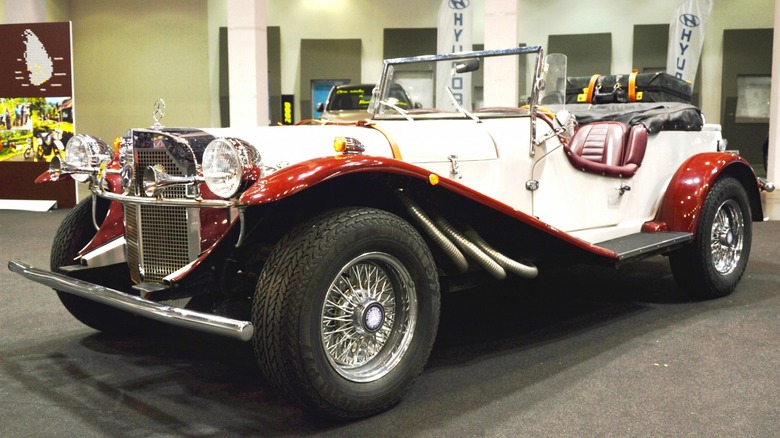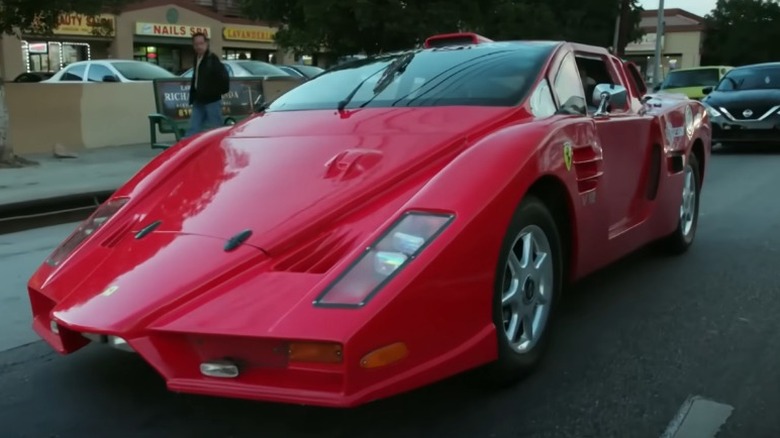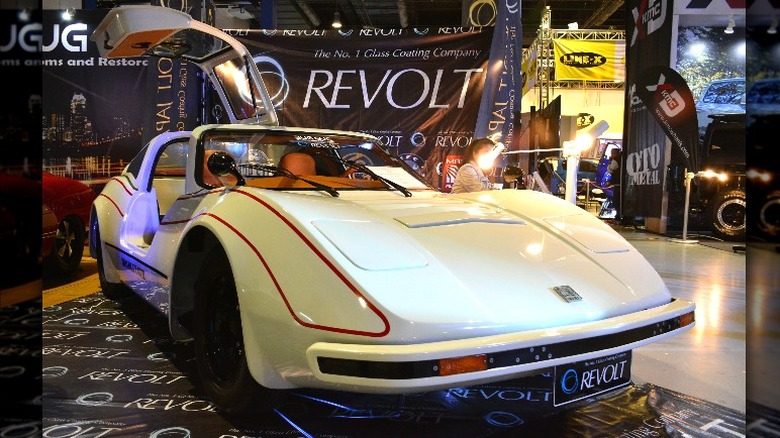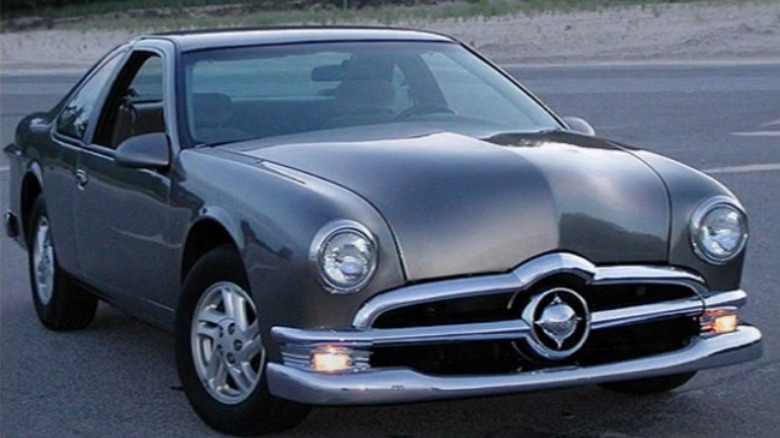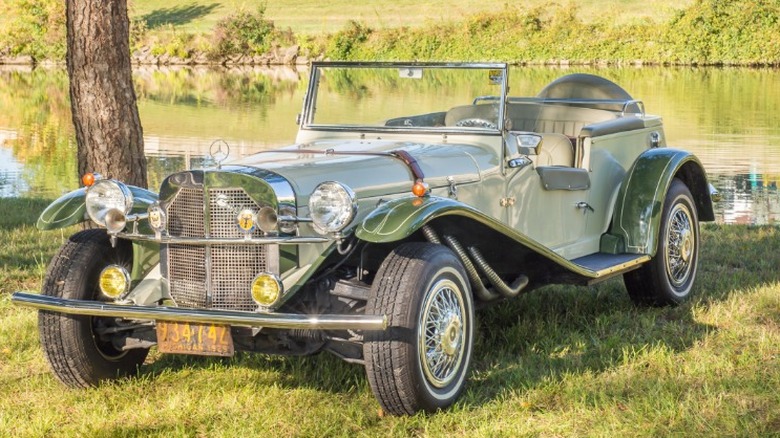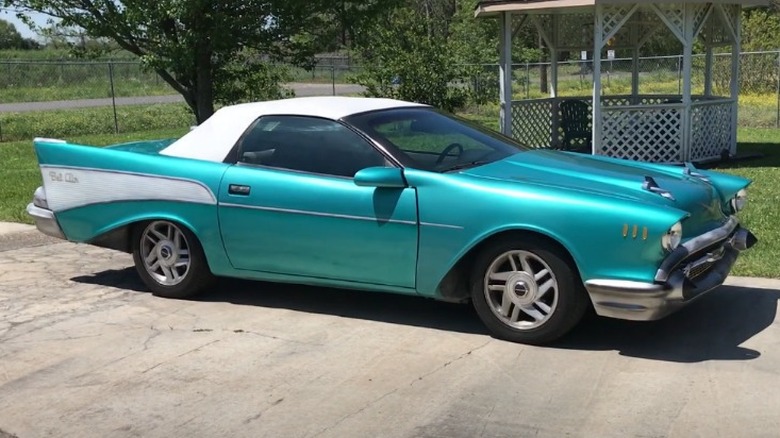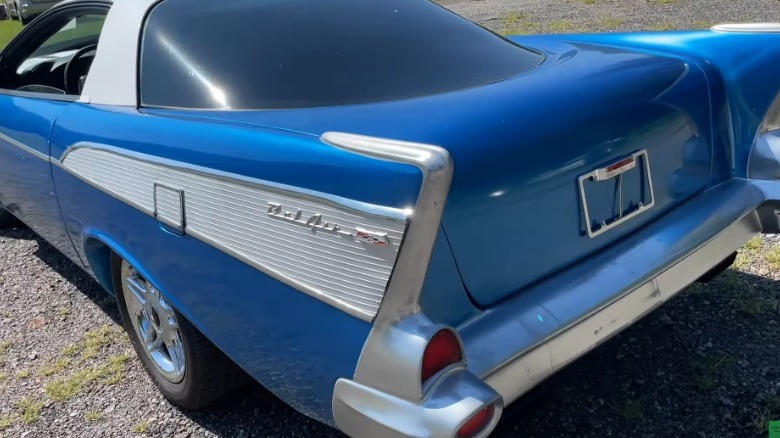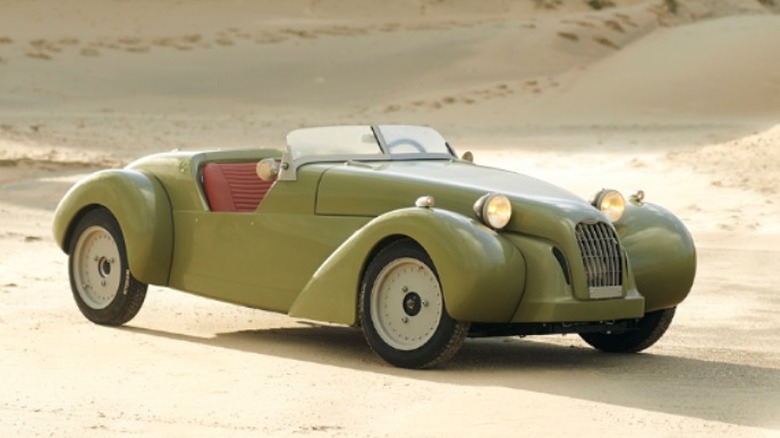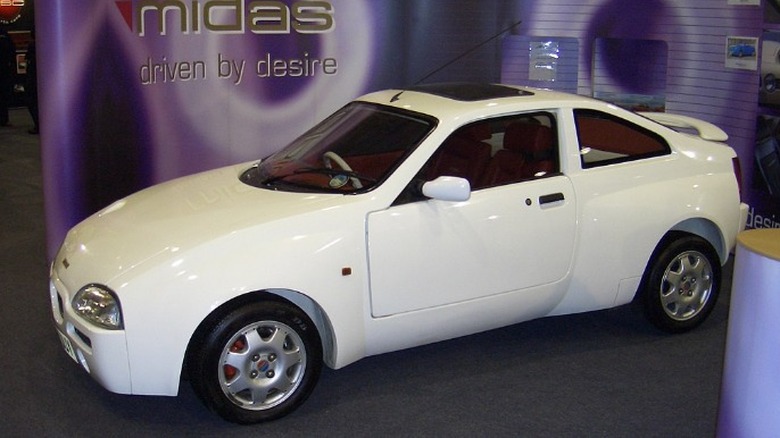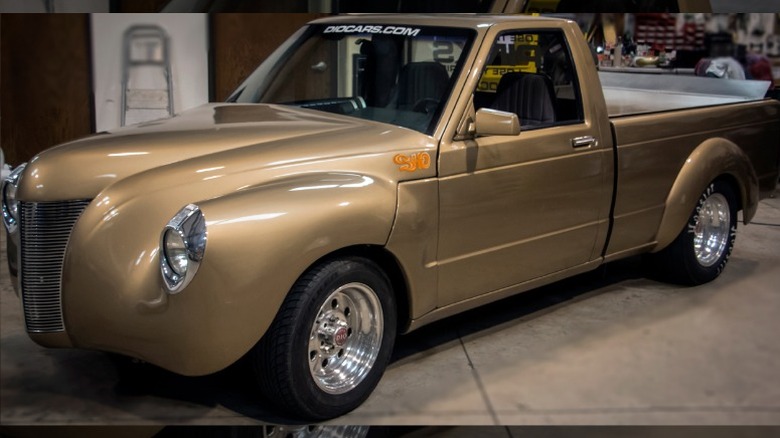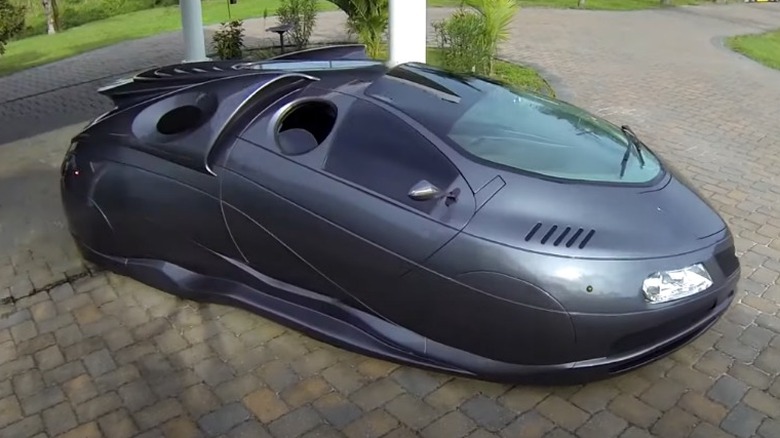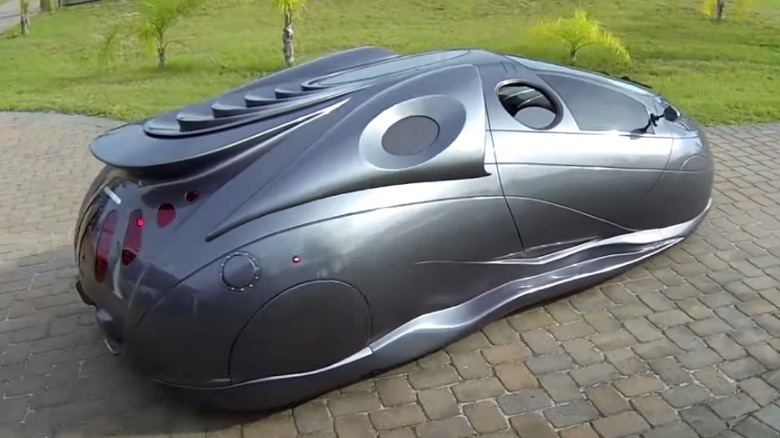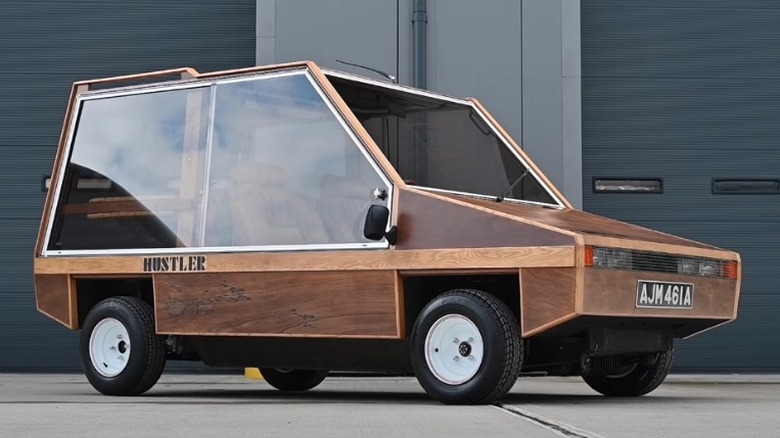10 Kit Cars You Should Absolutely Stay Away From
From the time that automobiles became available to the general public, especially the Model T, inventive and clever people have modified and assembled them in myriad configurations and styles. Some of the earliest modified cars were done in line with the time-honored tradition of racing, as humans have participated in various methods of the sport for all of our history. Later modified cars sprung from the days of prohibition, with bootleggers increasing the power of their cars to get away from lawmen seeking arrest for illegal liquor production. This tradition would eventually turn into the NASCAR racing series.
The business of modified cars grew significantly in the '50s and coincided with the development of a kind of DIY project called the kit car. These come in various forms and formats but mostly include a number of prefabricated parts purchased and assembled by individuals, usually in their own garages. Some of these are kits meant to be fitted to an existing chassis while others are complete kits made for a car to be built from scratch. An example of a highly successful kit car is the Lotus 7, which was offered by Lotus founder Colin Chapman as a complete chassis and body in which the builder could install their choice of engine and gearbox. Since then dozens of models have come and gone and a few companies remain today offering excellent choices of home-built cars, such as Factory Five and Caterham. However, many of these cars over the years have been real stinkers, so here are 10 models you should stay away from.
Fierrari
A highly popular form of kit cars exists to replicate some of the most highly valued and exotic supercars from various eras. Ferrari is a common choice for this kind of replica and several manufacturers have offered Ferrari kits over the years. Many of these are based on mid-engine cars, and the Pontiac Fiero makes an excellent base as it is an affordable and widely available model in North America.
The problem is the dimensions of the Fiero hardly match up to cars such as the 308 or Testarossa, and kits for these cars end up looking like distorted versions of the original, like this Ford GT40 kit. Only at a glance will most people mistake them for an Italian supercar. Furthermore, only with considerable modifications can an engine of considerable power be installed in a Fiero, although a V8 can be done. Some industrious Italian car fans have created stunning and high-quality replicas such as this Lamborghini Miura, which is almost indiscernible from the original. But it was not built from a kit and represents hundreds of hours of custom fabrication and bodywork to get to the end result. Prefabricated kits will not end up with the same kind of results.
For a perfect representation of how a Fiero kit can go so horribly wrong, you can see Jay Leno drive one in an episode of his show. For all the time, money, and effort you could put into building one of these kits, you could build a custom original Fiero that would be much more impressive than a fake Ferrari.
Bradley GT
Bradley was a company offering kit cars throughout the '70s and made enough of them that many car enthusiasts are likely familiar with them. They are also dead simple projects relying on Volkswagen architecture to complete the build. The Bradley features a fiberglass body, with gullwing doors, that is built to fit perfectly on a Volkswagen Type 1 Beetle chassis. They are definitely cool-looking cars, although the hand-built nature of the interiors tends to be obvious. The seats are molded fiberglass and they and the rest of the interior are covered in choice '70s vinyl. Bradley eventually went bankrupt and was completely defunct by 1981.
Bradleys are the kind of car that will draw attention at a car meet and they do sit low to the ground, likely giving them go-kart-like handling. So yes, they are kind of cool, but that is the rub. For a sporty car that apes a classic Porsche or even borrows cues from classic Le Mans racers, they are a VW Beetle at heart. That means the horsepower potential is extremely low. From the factory, the most powerful engine produced just 60 horsepower. Modifications can be made to get north of 200 horsepower, but the kind of money to do that can add up quickly. To dump thousands of dollars into a car with a molded fiberglass body with a cheap-looking interior does not make a lot of sense. With Bradleys now inching up toward $10,000 in value, a well-sorted classic Triumph Spitfire 1500 or nice MGB might be a better choice.
EasyRods Thunderbird
There is a company that has been around for a few years offering a couple of conversion kits including one that requires one of the later-year model Ford Thunderbirds as a donor car. Unlike a VW-based kit that only uses the chassis, this one retains much of the body and grafts its modification to the front and rear. For reasons that are not easily discernible, this kit makes your T-bird look similar to a 1949-1951 Ford coupe.
EasyRods offers this kit as a bolt and glue-on application. The front half replaces the hood and fenders using the factory mounting points, and the rear uses panels molded to fit over the stock quarter panels and glued into place with some screws for a secure fit. The end result looks like neither a car from the '50s nor a car from the '90s, and the curves at the front completely clash with the windows and door frames from the base car. The cost for this kit is currently $3,595. It will require a bit of bodywork to ensure smooth and seamless integration and a complete paint job will also be necessary. With prices of the '80s-'90s T-birds on the rise, this complete kit could easily run into the $20,000 range. For that much cash, it might be better to get an actual classic Ford and avoid the side eye from passers-by.
Gazelle
In the '20s and '30s, Mercedes-Benz was making some of the finest motorcars in the world. Among the best of these models was the 1928 SSK, a two-seat roadster with a supercharged straight-8 making 300 horsepower and the most powerful car made at the time. It is a thing of beauty, but it is exceedingly rare and nearly priceless as only a few were ever built.
However, in the '70s and '80s, anyone could order a kit to build a car resembling this timeless classic. Classic Motor Carriages, Fiberfab, Tiffany Motor Cars, and more created DIY copies of the SSK. Based on the platforms of the VW Beetle, Chevrolet Chevette, or Ford Pinto, most of them were marketed as a Gazelle. While the SSK was the most powerful car in the world in its day, the Gazelle is underpinned by the least powerful cars of their day.
While at least one company produced these kits into the early '90s, the rest went bankrupt as mullets and heavy metal crept into popular culture. Later models can still be found for sale in good condition, although their anachronistic nature remains strong. It is the earlier models that probably should be avoided. While the original SSK was hand-built by the finest engineers and craftsmen Germany had to offer, the earlier Gazelles were (probably) built by Tom, a guy with a plumbing business and a bad back in his garage on the weekends. The build quality is a crapshoot and the underlying technology is still from the cheapest cars of the '70s, an era not well-known for good automobile manufacturing.
EasyRods Belaro
EasyRods makes another appearance with an offering to take advantage of a platform from Ford's main rival, Chevy. The 1957 Chevy Bel Air is probably the most recognizable and popular family car of the '50s and is a favorite among hot rodders and restoration specialists. GM sold 1.5 million copies of this car, which means there are a lot of them still around. EasyRod's claim that 1957 Bel Air coupes can cost $50,000 is substantiated by a recent search on Bring a Trailer, but that does not necessarily mean a Camaro-based version is an ideal alternative.
The Belaro kit works much like the Ford variety and parts for the front use factory mounting points while the rear is glued and screwed into place. Custom paint is also in order for an acceptable finished look overall. However, the proportions are skewed in such a way that the car once again looks like neither a Camaro nor a Bel Air.
Prices for fourth-gen Camaros are also on the rise, and good condition and driveable models are selling on Bring a Trailer in a range of $15,000 to $30,000, depending on the model and mileage. For the cost of acquiring one of these cars and adding this kit, you would likely have nearly enough money to buy a real 1957 Bel Air. But most importantly, a classic Bel Air is almost certain to appreciate, while a Belaro could be a hard sell.
Burton
Kit cars are not a purely American phenomenon and many have come from Europe. Netherlands-based Burton creates admittedly attractive cars based on the lowly French Citroën 2CV. However, calling the 2CV lowly is not meant to be disparaging, it is just that the car was designed after WWII to be the most basic, cheap, and capable car for a populace ravaged by years of mechanized warfare. The 2CV is a fine little car, but it is anything but sporty.
Burton creates a bolt-on shell of fiberglass body panels meant to match up perfectly to a 2CV chassis. These conversions are available as a kit, but Burton also manufactures complete cars ready for the road. The styling is reminiscent of classic Bugattis and MGs but retains a few nods to the Citroën underneath, such as the external headlight pods. Burton has also been in business since the '70s and has done so well that the company offers a full line of replacement parts for the 2CV. Kits start at €4,499 and they sell used models starting at €12,500.
With all that you might think there is no reason not to buy one. Considering the stock engine in a 2CV is no more than 600cc and power output, depending on year model, ranges from 9 in the original to 33 in the last ones made — production ended in 1988 — the Burton is very slow. For the money to buy or build one of these, there are dozens of European alternatives that look just as good while offering more comfort, more power, and more refinement.
Midas Cortez
In the 1960s, British automaker Austin created a sensation with its new pint-sized automobile called Mini. It was a huge success and went on to sell millions of copies on multiple continents for decades until production of the original design finally ended in 2000. Ample production of the model meant that there are countless copies all over the U.K., and a company called Midas took to converting them into something else starting in 1978.
Like other kits, the body is a molded fiberglass shell riding that uses the Mini subframe under the engine with a beam to support the rear suspension — the Mini uses a monocoque chassis. In the '80s, adaptations to the kit were made to use the Austin Metro as its base, which continued until that became the Rover Metro. The Rover-based kits are still in production today, although ownership of the company has changed hands many times.
Unlike many retro-styled kits, Midas offers modern designs with modern interiors. It might be hard to argue that the Midas kits improve on the looks of the Mini as it is a classic design that remains popular and attractive to many. The Metro is another story as it is a basic economy car with very basic economy styling that was never meant to sell on its looks. The £4,500+ kits may very well improve upon the looks of a Metro and be a peculiar little car, but to spend thousands of pounds to cut up a Mini when that money could very well go toward one in excellent running condition is a decision that would be harder to justify.
[Featured image by JAC2008 via Wikimedia Commons | Cropped and scaled | Public domain]
Dio S-40
Diocars is an interesting manufacturer in Oklahoma City that began production in 1991. The first car developed by the company is the Dio Tipo 61, an homage to the illustrious Maserati Tipo 61 "birdcage" race car of the '60s. The company's website states that this model can be built on the chassis of a Triumph, MGA, Datsun 1600, or a VW chassis and that plans for building a tube chassis are also available. The resulting car is a stunning piece of work very near to the original. With a V8 as is shown in the pictures gallery, the little Dio would be a potent little racer.
The Dio S-40 is a completely different story. Using a Chevrolet S-10 as its basis, the S-40 kit is a fiberglass front end using factory mounting points. The result of this modification is a small '80s truck with the front end of a 1940s Ford Pickup. The light truck DNA is inescapable and the dimensions are so off as to be an assault on the eyes. The deluxe kit runs $6495 and with S-10 values right now, this kit could get expensive in a hurry. Classic shows the 1982 to 1992 S-10 models in clean condition are selling north of $10,000 at the moment, making an S-40 project easily cost more than $20,000. If you want a truck with the pre-war look, Classic also shows around a dozen sold listings in this category for less than $30,000, and they require no additional work to get the old truck style.
Vetter ETV
The Vetter company is a bit different from most kit car companies, but it has its roots in the Fiero/Countach replica builds of the '90s. A teenage Mike Vetter first built a Countach replica for himself as a teenager and parlayed his experience into a business building them for others. At some point, Ferrari came calling armed with cease and desist letters and Lamborghini soon followed. Rather than calling it quits, he chose to create his own designs.
The current models offered by Vetter are built by his company rather than offered as kits. They are built atop existing cars that are thoroughly modified such that the original is no longer evident until you see inside. The ETV, or Extra Terrestrial Vehicle, is a bulbous and futuristic concept that is built mostly on Chevy Cobalts and Aveos with the original interiors intact, although other cars have been used, including a Porsche Boxster.
These creations are not cheap, although the available info is confusing, especially since the Vetter website, drawingtodriving.com, was down at the time of writing. Auto Evolution reported that the first ETV creation in 2014 was priced at nearly $100,000. However, a Wayback Machine cache of a Bonham's auction showed the reserve was met at £5,100. Regardless, no matter how cool – or uncool – it may look, how much is a car really worth when driving it will be no different from driving a Cobalt or Aveo? To those who relish the driving experience, that would be a non-starter, and driving a Prius kit car built atop a Corvette or Ferrari would be preferable.
Hustler
Most kit cars are built using an existing car made primarily of metal with a fiberglass shell sitting over it, but not all kit cars are developed like this. Yet, having a kit car designed by the man responsible for the Aston Martin Lagonda and the Bulldog concept who is hailed as a hero of British automotive design is a matter of perspective.
William Towns worked for Aston Martin but also penned cars for Jensen and Lotus. He later spent considerable time on his own project called Hustler. These are tiny city cars based on Minis and other platforms, including electric, that feature many straight lines, sharp creases, and huge windows. The influence of the Lagonda and Bulldog are evident throughout many models he offered as kits for the home mechanic to build.
Some of the clever Hustler models would be very cool to own and likely highly practical in the smaller villages of Europe. However, at least one model could have issues. The model is the Hustler in Wood. It is so-named due to the kit being available only as a frame with plans for building the body panels from lumber included. Most blokes with a shed should have the skills to do this. Truthfully, any one of these cars would be amazing novelties to own and probably should be picked up if the chance arises. But it might also be a good idea to be very wary of them as wood rots and deteriorates over time and you also want to stay away from any car infested with termites.
